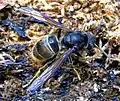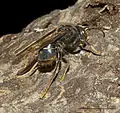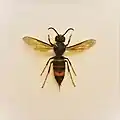Asian hornet
The Asian hornet (Vespa velutina), also known as the yellow-legged hornet or Asian predatory wasp, is a species of hornet indigenous to Southeast Asia. It is of concern as an invasive species in some other countries.[1]
| Asian Hornet | |
|---|---|
.jpg.webp) | |
| Scientific classification | |
| Kingdom: | Animalia |
| Phylum: | Arthropoda |
| Class: | Insecta |
| Order: | Hymenoptera |
| Family: | Vespidae |
| Genus: | Vespa |
| Species: | V. velutina |
| Binomial name | |
| Vespa velutina Lepeletier, 1836 | |
_(2).jpg.webp)
Appearance
Vespa velutina is slightly smaller than the European hornet. Typically, queens are 30 mm (1.2 in) in length, and males about 24 mm (0.95 in). Workers measure about 20 mm (0.80 in) in length.[2] The species has distinctive yellow tarsi (legs). The thorax is a velvety brown or black with a brown abdomen. Each abdominal segment has a narrow posterior yellow border, except for the fourth segment, which is orange. The head is black and the face yellow. Regional forms vary sufficiently in color to cause difficulties in classification, and several subspecies have been variously identified and ultimately rejected; while a history of recognizing subspecies within many of the Vespa species exists, including V. velutina, the most recent taxonomic revision of the genus treats all subspecific names in the genus Vespa as synonyms, effectively relegating them to no more than informal names for regional color forms.[3] The color form causing concern about its invasiveness in Europe has been referred to as V. v. nigrithorax,[4] though this name no longer has any taxonomic standing.[3]
Biology
Like other hornets, V. velutina builds nests that may house colonies of several thousand individuals.[5] Females in the colony are armed with formidable stingers with which they defend their nests and kill their prey. The nest is of paper, roughly in the shape of a huge egg, usually at least half a meter long. Unlike the nest of the European hornet (V. crabro), its exit is usually lateral rather than at the bottom. The nesting season is long, and a colony commonly begins by building a nest in a low shrub, then abandoning it after some months and rapidly building a new one high in a tree, possibly as an antiparasitic measure. The next generation of young queens disperses in the late autumn to hibernate over winter.[6]
 V. velutina nest on tree
V. velutina nest on tree V. velutina nest
V. velutina nest_-3.jpg.webp) Inner structure of nest
Inner structure of nest V. velutina from the Central Himalayas, India
V. velutina from the Central Himalayas, India
V. velutina opportunistically hunts a very wide range of insects, including flies, dragonflies, and Orthoptera, typically capturing them by pursuit.[2]
Predation on honeybees
The major concern about their invasiveness, however, is that when they find a honey bee colony or an apiary, they tend to settle down and specialize in honey bees as their prey, as do the larger Japanese giant hornets. A hornet occupies a position above a beehive as its hunting territory. It flies about within an area of about half a square metre, scanning the direction from which foraging honey bees return to the hive. Each hornet vigorously defends its hunting territory, chasing off any rivals. However, as soon as it catches a bee, it flies off and another hornet replaces it, usually within a few seconds. The circadian activities of the two species of honey bees are similar, and the hunting hornets match them; their most intense activity is in the morning and afternoon, not near dusk or noon.[1]
In its native range, V. velutina mainly hunts Apis cerana, the eastern honey bee, which has evolved a strategy of avoiding hovering hornets by rapid entry and exit from the hive when hornets are about. The guard bees also ball hornets to death. However, where A. mellifera, the western honey bee, has been imported, V. velutina finds them easier prey than A. cerana, because A. mellifera has not been subjected to selection for countering concentrated hawking by hornets. For example, A. mellifera approach their hives more indirectly and slowly when they detect hawking hornets, instead of darting in as fast as possible in the way that A. cerana does. They also ball hornets, but less effectively, and they do not achieve as high a temperature in the ball. Furthermore, when they detect that hornets are hawking, A. cerana tend to withdraw into the nest, but A. mellifera do not.[1]
A. cerana guard bees also use wing shimmering in response to the presence of V. velutina. This is a very generalized response to disturbance and has variously been suggested to be an aposematic signal or a strategy for disruption of visual patterns, similar to the behavior of Apis cerana nuluensis and Apis dorsata.[7] A. mellifera exhibits no such behavior. In any event, when A. mellifera occurs together with A. cerana, V. velutina preferentially hawks A. mellifera foragers.[1]
Distribution
_across_south-east_Asia.png.webp)
V. velutina originates from Southeast Asia, particularly the tropical regions, from northern India, Pakistan, Afghanistan, Bhutan, China, Taiwan, Burma, Thailand, Laos, Vietnam, Malaysia, the Indo-Chinese peninsula, and surrounding archipelagoes.[3]
Pest status and invasiveness
As an invader, the Asian hornet appeared earliest in France, Spain, Portugal, South Korea, and Japan. Further invasions are ongoing in various countries, including much of Europe.[8] Humans have been attacked after disturbing hornets; although the species is not aggressive, it "charges in a group as soon as it feels its nest is threatened".[5] People have been hospitalised in France after suffering anaphylactic shock as a result of multiple stings. Because of Asian hornets' larger size, their stings are more serious than those of western honey bees. In November 2017, a man was killed in Galicia, Spain after being stung over 20 times while pruning an apple tree.[9] Several people have died in south west France near the original introduction site, including a resident of Chaillevette, Charente-Maritime,[10] a 60 year old woman in Gironde, Nouvelle-Aquitaine in 2019,[11] and a farmer in Orival, Charente in 2020.[12] There were eighteen confirmed Asian hornet sightings in England between 2016 and 2019, including nine nests, all of which were destroyed.[13]
Timeline
V. velutina has become an invasive species in France, where it is believed to have arrived in boxes of pottery from China in 2004.[14] By 2009, several thousand nests were in the area of Bordeaux and surrounding departments,[15][16] and by the end of 2015, they were reported over most of France.[17]
The Asian hornet has been reported as naturalised on the Japanese island of Tsushima since about 2010.[18]
The Asian hornet spread to northern Spain, as confirmed in 2010 by the Beekeepers' Association of the Basque Country (Gipuzkoako Erlezainen Elkartea) and the Neiker entomology institute in Irún, after breeding colonies were found.[19] In September 2013, a beekeeper from Rasines, Cantabria, documented the hornets' presence in two specimens.[20] In June 2015, firemen destroyed a nest in Santander.[21]
It was first reported in Portugal in 2011.[22]
It was reported in Liguria, Italy in 2012.[23] According to Italian Beekepers' Association in 2017, the Asian hornet was well established in northwestern regions of Italy, and colonization is steadily advancing.[24]
The first sighting on the UK mainland was announced on 20 September 2016 and occurred near Tetbury in Gloucestershire; the nest was found and destroyed and no breeding adults were found within.[25] A nest was reported on the Channel Island of Alderney in 2016.[26]
As of October 2017, the species was reported in Belgium.[27]
It was first reported in Luxembourg in 2020.[28]
Biocontrol
Biocontrol of Vespa velutina has been attempted using Sarracenia purpurea - the purple pitcher plant. Pitcher plants are natural bottle traps. Both of these are invasives in France and pitchers were found to be naturally catching hornets, and so were investigated as a biocontrol.[29] However Sarracenia purpurea has been judged too unselective to use after closer study.[30][31]
Gallery
 V. velutina - usual color variant, dorsal aspect
V. velutina - usual color variant, dorsal aspect V. velutina - usual color variant, lateral aspect
V. velutina - usual color variant, lateral aspect V. velutina color form nigrithorax, dark color variant - Toulouse
V. velutina color form nigrithorax, dark color variant - Toulouse Nest of V. velutina about 30 feet up on a durian tree in Malaysia
Nest of V. velutina about 30 feet up on a durian tree in Malaysia Mounted specimen
Mounted specimen Female of V. velutina, private collection, F. Turetta
Female of V. velutina, private collection, F. Turetta
References
- Tan, K.; Radloff, S. E.; Li, J. J.; Hepburn, H. R.; Yang, M. X.; Zhang, L. J.; Neumann, P. (Jun 2007). "Bee-hawking by the wasp, Vespa velutina, on the honeybees Apis cerana and A. mellifera". Naturwissenschaften. 94 (6): 469–72. doi:10.1007/s00114-006-0210-2. PMID 17235596.
- Lee, John X. Q. "Vespa velutina". vespa-bicolor.net. Archived from the original on 10 February 2018.
- A.H. Smith-Pardo, J.M. Carpenter, L. Kimsey (2020) The diversity of hornets in the genus Vespa (Hymenoptera: Vespidae; Vespinae), their importance and interceptions in the United States. Insect Systematics and Diversity 4(3) https://doi.org/10.1093/isd/ixaa006
- "Pitcher plant in France eats bee-killing Asian hornets". BBC News. 10 August 2015. Archived from the original on 6 February 2018.
- Samuel, Henry (19 August 2009). "Tourists warned as Asian hornets terrorise French". The Daily Telegraph. Archived from the original on 5 May 2016.
- Vespa velutina In: Invasive Species Compendium 2014. Wallingford, UK: CAB International. www.cabi.org/isc
- Koeniger, N.; Koeniger, G.; Gries, M.; Tingek, S.; Kelitu, A.. (1996). "Observations on colony defense of Apis nuluensis and predatory behaviour of the hornet, Vespa multimaculata Pérez, 1910" (PDF). Apidologie. 27: 341–352. doi:10.1051/apido:19960502. ISSN 0044-8435.
- Monceau, Karine; Bonnard, Olivier; Thiéry, Denis (2014). "Vespa velutina: a new invasive predator of honeybees in Europe". Journal of Pest Science. 87 (1): 1–16. doi:10.1007/s10340-013-0537-3.
- "Morre un veciño do Porriño atacado por avespas velutinas mentres cortaba unha árbore". CRTVG (in Galician). 15 November 2017. Archived from the original on 24 April 2018.
- O.Riou, C.Hinckel et (2015-11-26). "Charente-Maritime : polémique sur la lutte contre les frelons asiatiques après la mort d'un habitant de Chaillevette". France 3 Nouvelle-Aquitaine (in French). Retrieved 2020-11-13.
- AR (2019-08-01). "Gironde : une sexagénaire décède après une piqûre de frelon asiatique à Grayan-et-l'Hôpital". France 3 Nouvelle-Aquitaine (in French). Retrieved 2020-11-13.
- Hinckel, Christine (2020-11-08). "Charente : un agriculteur meurt attaqué par un essaim de frelons asiatiques". France 3 Nouvelle-Aquitaine (in French). Retrieved 2020-11-13.
- "Asian hornet: UK sightings". UK Government. 15 September 2020. Retrieved 9 December 2020. Page gets updated with details of further sightings.
- Saner, Emine (17 October 2011). "Danger! The bee-killing Asian hornet is set to invade Britain". The Guardian.
- http://spn.mnhn.fr/spn_rapports/archivage_rapports/2009/SPN%202009%20-%207%20-%20Vespa%20velutina.pdf
- Villemant, Claire; Muller, Franck; Rome, Quentin; Thierry, Denis (October 2009). "Evaluation des populations du Frelon asiatique (Vespa velutina, Lepeletier 1836) en France: Conséquences écologiques et socio-économiques. Proposition de mise en œuvre d'un plan d'action" (PDF) (in French). Muséum National d'Histoire Naturelle. Archived (PDF) from the original on 31 July 2018.
- Léveillé, Patricia (18 February 2013). "Lutte contre le frelon asiatique à pattes jaunes" (in French). French National Institute for Agricultural Research. Archived from the original on 28 February 2019. Retrieved 20 March 2019.
- "外来種ツマアカスズメバチの巣採取 数年前から対馬に帰化". Yomiuri Shimbun (in Japanese). 18 September 2013. Archived from the original on 22 September 2013.
- Bee killing Asian hornet confirmed in Spain Archived November 26, 2010, at the Wayback Machine, The Reader, November 21, 2010
- "La avispa asiatica ´devora-abejas´ llega Cantabria". rtve.es/. 16 October 2013. Retrieved 29 June 2015.
- "Retiran un panal de avispa asiática en Santander". Europa Press (in Spanish). 24 June 2015. Retrieved 29 June 2015.
- Cruz, Andrea (28 September 2013). "Já foram destruídos 78 ninhos de vespa asiática em Viana do Castelo". Público (in Portuguese).
- "Cresce l'allarme in Italia per la vespa velutina". la Repubblica (in Italian). 6 December 2006. Archived from the original on 25 January 2017.
- Velutina - Dov'è. "Mappa degli avvistamenti". Stop-Velutina.
- "Asian hornet identified in Gloucestershire". GOV.UK. 20 September 2016. Retrieved 21 September 2016.
- "Asian hornet identified for the first time in the Channel Islands". Pest Control News. 12 July 2016. Archived from the original on 11 October 2016. Retrieved 12 July 2016.
- Matyn, Joppe (4 October 2017). "Allesverslindende "monsterwesp" opnieuw gesignaleerd in Vlaanderen" (in Dutch). Archived from the original on 12 February 2019.
- Ries, C. & M. Pfeiffenschneider (Eds.), 2020. Vespa velutina nigrithorax du Buysson, 1905. In: neobiota.lu - Invasive Alien Species in Luxembourg. National Museum of Natural History, Luxembourg. URL: https://neobiota.lu/vespa-velutina/ [Accessed 2020-09-15].
- "Morphological, colour and odour traits of Sarracenia pitcher plants involved in the capture of the Asian hornet presented by C. Dupont , D. Gomez and L. Gaume" (PDF).
- "Wycke M-A, Perrocheau R, Darrouzet E (2018) Sarracenia carnivorous plants cannot serve as efficient biological control of the invasive hornet Vespa velutina nigrithorax in Europe. Rethinking Ecology 3: 41-50. DOI 10.3897/rethinkingecology.3.28516".
- "Can carnivorous plants control an invasive hornet?".
External links
 Media related to Vespa velutina at Wikimedia Commons
Media related to Vespa velutina at Wikimedia Commons Data related to Vespa velutina at Wikispecies
Data related to Vespa velutina at Wikispecies- NNSS website for reporting sightings in Great Britain